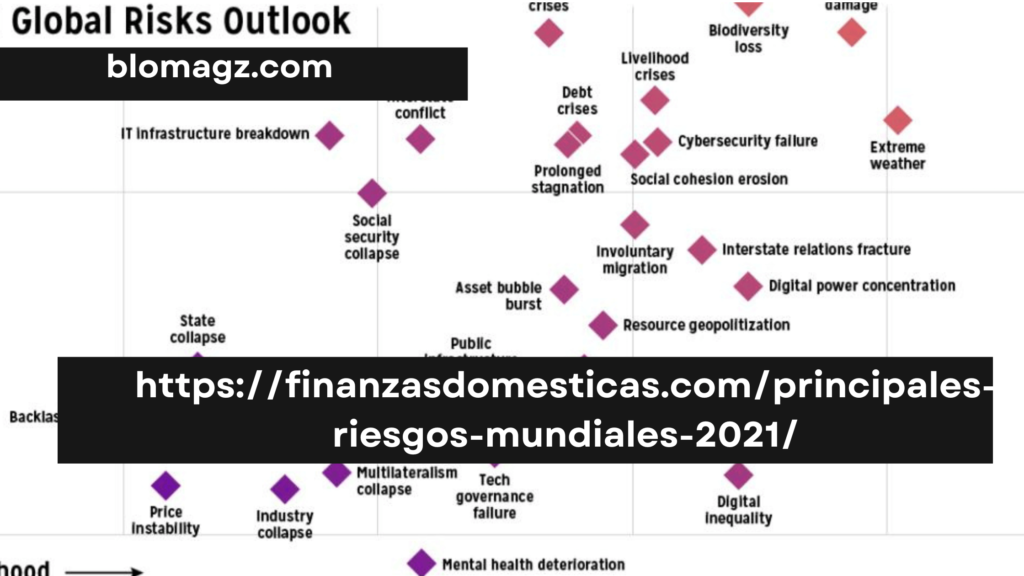Introduction to https://finanzasdomesticas.com/principales-riesgos-mundiales-2021/
2021 was a year marked by unprecedented challenges, where the confluence of several global risks pushed humanity into uncharted territory. These risks were not isolated; they intertwined, amplifying each other’s effects and creating a complex web of challenges that required coordinated global responses. From the lingering impacts of the COVID-19 pandemic to the intensifying climate crisis, cybersecurity threats, and geopolitical tensions, the risks of 2021 painted a picture of a world in flux, grappling with both the immediate and long-term consequences of these threats. This article delves into the main global risks of 2021(https://finanzasdomesticas.com/principales-riesgos-mundiales-2021/), exploring their origins, impacts, and the strategies needed to address them.
Pandemic
The COVID-19 pandemic continued to dominate global concerns in 2021, evolving from a health crisis into a multifaceted global emergency. The year witnessed the emergence of new variants, such as Delta and Omicron, which threatened to undermine vaccination efforts and prolong the pandemic. Vaccine distribution challenges, particularly in low-income countries, highlighted the disparities in global health systems and the difficulty in achieving global herd immunity. Additionally, the pandemic exposed the vulnerabilities in global health infrastructure, leading to calls for significant reforms and investment in healthcare systems worldwide.
Health Crises
Beyond COVID-19, other health crises loomed, including the resurgence of diseases like tuberculosis and the ongoing battle against HIV/AIDS. The strain on global health systems, exacerbated by the pandemic, left many nations ill-prepared to address these concurrent health challenges. The year underscored the need for a robust, coordinated global health strategy to tackle not only COVID-19 but future pandemics and health crises.
Economic Instability
The economic fallout from the pandemic persisted in 2021, with many countries struggling to recover from the deep recessions triggered by prolonged lockdowns and reduced economic activity. The uneven pace of recovery between developed and developing nations exacerbated global inequalities, with poorer countries facing greater difficulties in reviving their economies. Unemployment remained high in many regions, and the informal economy, which supports millions of people worldwide, was particularly hard-hit.
Inflationary pressures
In addition to these challenges, inflationary pressures began to mount as supply chain disruptions and increased demand led to higher prices for goods and services. Central banks faced difficult choices in balancing the need for economic stimulus with the risk of stoking inflation. The economic instability of 2021 highlighted the fragility of the global economy and the importance of building more resilient economic systems capable of withstanding future shocks.
Climate Change
Climate change continued to be one of the most pressing global risks in 2021, with the year marked by a series of extreme weather events that underscored the urgency of the climate crisis. From devastating wildfires in California and Greece to catastrophic floods in Germany and China, the impacts of climate change were felt worldwide. These events served as stark reminders of the need for immediate and sustained action to mitigate the effects of global warming and prevent further environmental degradation.
Environmental Degradation
The global response to climate change in 2021 included significant international efforts, such as the COP26 summit in Glasgow, where nations committed to reducing greenhouse gas emissions and transitioning to renewable energy sources. However, despite these efforts, challenges remained in achieving the necessary reductions to limit global warming to 1.5°C above pre-industrial levels. The year also saw increased attention to issues such as biodiversity loss, deforestation, and the degradation of oceans, highlighting the interconnectedness of environmental challenges and the need for comprehensive solutions.
Cybersecurity Threats
As the world became more digitally connected in 2021, the threat of cybersecurity breaches grew exponentially. High-profile cyber-attacks, such as the Colonial Pipeline ransomware attack in the United States and the SolarWinds hack, brought attention to the vulnerabilities in global digital infrastructure. These incidents demonstrated the potential for cyber threats to disrupt critical services, compromise sensitive data, and even influence geopolitical dynamics.
Potential Threats
The rise in cybercrime, including phishing scams, ransomware attacks, and data breaches, placed immense pressure on organizations and governments to enhance their cybersecurity measures. However, the rapid pace of technological innovation outpaced the ability to secure these systems effectively, leading to a growing sense of insecurity in the digital realm. The cybersecurity threats of 2021 underscored the need for international cooperation, investment in cybersecurity infrastructure, and the development of robust regulatory frameworks to protect against future attacks.
Geopolitical Tensions
Geopolitical risks escalated in 2021, driven by shifting power dynamics and unresolved conflicts. The U.S.-China relationship remained a focal point, with tensions over trade, technology, and human rights issues continuing to strain diplomatic ties. The competition for global influence between these two superpowers had wide-reaching implications, affecting everything from global supply chains to international security.
Regional conflicts
In addition to U.S.-China tensions, regional conflicts in places like the Middle East, Eastern Europe, and the South China Sea continued to pose significant risks. The situation in Afghanistan, where the Taliban regained control after the withdrawal of U.S. and NATO forces, added to the geopolitical uncertainty. These tensions not only threatened regional stability but also had the potential to disrupt global peace and security.
Social Unrest
The social fabric of many countries was tested in 2021 as rising inequality and social unrest became increasingly prominent global risks. The economic disparities exacerbated by the pandemic fueled protests and movements for social justice in various regions. Issues such as racial inequality, gender discrimination, and the rights of marginalized communities gained renewed attention, leading to widespread calls for reform.
Inequality
The pandemic also highlighted the disparities in access to healthcare, education, and economic opportunities, with vulnerable populations bearing the brunt of the crisis. The growing divide between the rich and the poor, both within and between countries, posed a significant challenge to social cohesion and stability. Addressing these inequalities became a critical priority, with the need for inclusive policies and social safety nets becoming more apparent.
Supply Chain Disruptions
Supply chain disruptions emerged as a significant global risk in 2021, affecting industries across the board. The pandemic, combined with natural disasters and geopolitical tensions, led to delays, shortages, and increased costs for goods ranging from semiconductors to basic consumer products. The global supply chain crisis exposed the vulnerabilities in just-in-time manufacturing systems and the overreliance on a few key suppliers, particularly in Asia.
These disruptions had far-reaching consequences, impacting everything from automobile production to the availability of electronic devices and medical supplies. The crisis also prompted a reevaluation of global supply chain strategies, with businesses and governments exploring ways to build more resilient and diversified supply networks to mitigate the impact of future disruptions.
Technological Disruptions
While technological advancements offered solutions to many of the challenges of 2021, they also brought new risks and ethical concerns. The rapid deployment of artificial intelligence, automation, and digital platforms raised questions about privacy, job displacement, and the concentration of power in the hands of a few tech giants. The potential misuse of technologies, such as deepfakes and surveillance tools, added to the growing list of technological risks.
Digital divide
Furthermore, the digital divide became more pronounced, with unequal access to technology exacerbating existing social and economic inequalities. The technological disruptions of 2021 highlighted the need for balanced and ethical approaches to innovation, ensuring that the benefits of technology are equitably distributed and that safeguards are in place to prevent its misuse.
Financial Market Volatility
Financial markets experienced significant volatility in 2021, driven by a combination of economic uncertainty, speculative investments, and the ongoing impact of the pandemic. The stock market saw dramatic swings, with sectors such as technology and healthcare experiencing rapid growth, while others, like energy and traditional retail, faced challenges. The rise of retail investors and the popularity of trading platforms like Robinhood contributed to market volatility, with events like the GameStop short squeeze capturing global attention.
Cryptocurrencies Role
Cryptocurrencies also played a prominent role in the financial landscape of 2021, with Bitcoin and other digital assets experiencing wild price fluctuations. The increasing interest in cryptocurrencies raised concerns about their regulation, environmental impact, and potential to disrupt traditional financial systems. The volatility of financial markets in 2021 underscored the need for careful monitoring and regulation to ensure stability and protect investors.
Political Polarization
Political polarization deepened in many countries in 2021, with divisions becoming more entrenched and public discourse increasingly polarized. The rise of populism, fueled by economic dissatisfaction and social media, contributed to a fragmented political landscape where consensus became harder to achieve. In the United States, the aftermath of the 2020 presidential election and the events of January 6 highlighted the fragility of democratic institutions and the challenges of maintaining a unified political culture.
The Impact of Polarization on Governance and Society
Misinformation
The spread of misinformation and disinformation continued to pose a significant risk in 2021, undermining public trust and complicating efforts to address global challenges. The COVID-19 pandemic, in particular, was accompanied by a flood of false information about vaccines, treatments, and the virus itself. Furthermore this misinformation contributed to vaccine hesitancy and resistance to public health measures, hampering efforts to control the pandemic.
Disinformation
Social media platforms played a central role in the dissemination of misinformation, with algorithms often amplifying sensationalist and misleading content. The challenge of combating misinformation required a multifaceted approach, including better regulation of online platforms, media literacy education, and efforts to promote credible sources of information. The battle against misinformation became a critical component of addressing the broader risks of 2021.
Global Governance Challenges
The effectiveness of global governance was put to the test in 2021 as international organizations struggled to coordinate responses to the pandemic, climate change, and other global risks. The uneven distribution of vaccines, disagreements over climate commitments, and the inability to resolve conflicts in regions like Syria and Yemen highlighted the limitations of existing global governance structures.
Weaknesses of multilateral institutions
The pandemic also exposed the weaknesses of multilateral institutions, with some countries prioritizing national interests over collective action. The challenges of 2021 (https://finanzasdomesticas.com/principales-riesgos-mundiales-2021/) underscored the need for reform in global governance, with a focus on enhancing the capacity of international organizations to respond to crises and fostering greater cooperation among nations.
Public Health Infrastructure
The strain on public health infrastructure was one of the most visible consequences of the COVID-19 pandemic in 2021. Health systems around the world faced unprecedented challenges, from overwhelmed hospitals to shortages of medical supplies and personnel. Furthermore the pandemic highlighted the need for significant investment in public health infrastructure to ensure that countries are better prepared for future health crises.
In addition to immediate responses to the pandemic, there was a growing recognition of the need for long-term reforms in global health systems. This included strengthening primary healthcare, improving access to medical care, and addressing the social determinants of health. The lessons learned from 2021 will be crucial in shaping the future of public health.
Food Security Concerns
Food security became a major concern in 2021 as disruptions to agricultural production, supply chains, and trade affected the availability and affordability of food. Climate change exacerbated these challenges, with extreme weather events damaging crops and reducing yields. The pandemic also contributed to food insecurity by disrupting livelihoods and increasing poverty, particularly in low-income countries.
Food Crises
The global food system faced significant challenges in meeting the needs of a growing population, with rising food prices and shortages impacting vulnerable communities the most. Addressing food security in 2021 required a focus on sustainable agriculture, resilience to climate change, and equitable access to food.
Energy Security Risks
Energy security emerged as a critical risk in 2021, driven by the transition to renewable energy, geopolitical tensions, and the volatility of energy markets. The push for decarbonization led to shifts in energy production and consumption, with renewable energy sources like wind and solar playing an increasingly important role. However, this transition also posed challenges, including the need for significant investment in energy infrastructure and the risk of supply disruptions.
Geopolitical Tensions and Energy Security
Geopolitical tensions, particularly in regions like the Middle East and Eastern Europe, further complicated the global energy landscape. Moreover the volatility of oil and gas prices, coupled with the impact of climate policies, created uncertainties for both energy producers and consumers. Ensuring energy security in 2021 required a balanced approach that addressed both the need for sustainable energy and the stability of supply.
Migration
The global migration and refugee crises continued to be a significant risk in 2021, driven by conflict, climate change, and economic instability.Additionally The number of displaced persons reached record levels, with millions of people fleeing violence, persecution, and environmental disasters. The situation in countries like Syria, Afghanistan, and Venezuela contributed to the growing number of refugees and asylum seekers.
Refugee Crises
The response to these crises varied, with some countries closing their borders or implementing restrictive immigration policies, while others sought to provide refuge and support to displaced populations. Furthurmore the migration and refugee crises of 2021 highlighted the need for comprehensive global strategies to address the root causes of displacement and provide humanitarian assistance to those in need.
Global Trade Tensions
Trade tensions remained a prominent global risk in 2021, with ongoing disputes between major economies impacting global commerce. The U.S.-China trade war, which began in previous years, continued to influence global trade patterns, with tariffs and trade barriers affecting a wide range of industries. The pandemic further disrupted trade, with supply chain bottlenecks and restrictions on the movement of goods leading to delays and increased costs.
Regional trade agreements
The rise of protectionism and the move towards regional trade agreements also shaped the global trade landscape in 2021. These developments raised concerns about the future of free trade and the potential for increased economic nationalism. Moreover addressing global trade tensions required efforts to promote open and fair trade, while also ensuring that trade policies were aligned with broader economic and social goals.
Human Rights and Freedoms
The erosion of human rights and freedoms became a critical issue in 2021, as governments around the world implemented measures to combat the pandemic that, in some cases, infringed on civil liberties. Restrictions on movement, surveillance, and censorship raised concerns about the long-term impact of these measures on human rights.
In addition to pandemic-related issues, there were ongoing concerns about the treatment of ethnic and religious minorities, the suppression of political dissent, and the rollback of democratic freedoms in various regions. The global human rights situation in 2021 highlighted the need for vigilance and advocacy to protect fundamental rights and freedoms.
Biodiversity Loss
Biodiversity loss continued to be a significant global risk in 2021, with the decline of species and ecosystems threatening the health of the planet. The destruction of habitats, pollution, and climate change contributed to the loss of biodiversity, with far-reaching consequences for food security, health, and the environment.
Additionally the global community recognized the importance of protecting biodiversity, with initiatives like the UN Decade on Ecosystem Restoration and the push for a new global biodiversity framework. However, challenges remained in achieving the necessary conservation targets and addressing the drivers of biodiversity loss. The year 2021 underscored the need for urgent action to protect the planet’s natural heritage.
Economic Recovery and Resilience
As the world sought to recover from the economic impact of the pandemic, the focus shifted to building resilience against future shocks. The economic recovery in 2021 was uneven, with some countries bouncing back quickly while others struggled to regain pre-pandemic levels of growth. Additionally the need for resilient economies that could withstand future crises became a central theme, with discussions on diversifying supply chains, investing in critical infrastructure, and promoting sustainable growth.
Furthermore efforts to build resilience also included addressing social inequalities and ensuring that recovery efforts were inclusive and equitable. The lessons learned from the economic challenges of 2021 will be critical in shaping future strategies for resilience and sustainability.
Mental Health Crisis
Conclusion
The main global risks in 2021 (https://finanzasdomesticas.com/principales-riesgos-mundiales-2021/) unprecedented challenges, with the confluence of multiple global risks creating a complex web of interconnected threats. From the lingering impacts of the COVID-19 pandemic to the intensifying climate crisis, cybersecurity threats, and geopolitical tensions, the world grappled with a range of issues that required coordinated global responses. The economic fallout from the pandemic, social unrest, and the erosion of human rights and freedoms further compounded these challenges. While the global community made efforts to address these risks, such as through international summits and initiatives, significant work remains to be done to build a more resilient and sustainable future.
Also Read: https://notipostingt.com/2022/04/26/los-mejores-hoteles-de-lujo-del-mundo-2022
FAQs
What were the main global risks in 2021?
The main global risks in 2021(https://finanzasdomesticas.com/principales-riesgos-mundiales-2021/) included the ongoing COVID-19 pandemic, climate change, cybersecurity threats, geopolitical tensions, economic instability, and social unrest.
How did the COVID-19 pandemic continue to impact the world in 2021?
The COVID-19 pandemic evolved from a health crisis into a multifaceted global emergency in 2021, with the emergence of new variants threatening vaccination efforts and prolonging the pandemic. Vaccine distribution challenges and the strain on global health systems exacerbated the crisis.
What were some of the key economic challenges in 2021?
Economic challenges in 2021 included uneven recovery between developed and developing nations, high unemployment, inflationary pressures, and the fragility of the global economy. Furthermore the pandemic’s economic fallout persisted, highlighting the need for more resilient economic systems.
How did climate change manifest in 2021?
Climate change was marked by a series of extreme weather events in 2021, including devastating wildfires and catastrophic floods, underscoring the urgency of the crisis. Despite international efforts like the COP26 summit, challenges remained in achieving the necessary emissions reductions.
What were some of the key geopolitical tensions in 2021?
Geopolitical tensions escalated in 2021, driven by the U.S.-China rivalry and regional conflicts in places like the Middle East, Eastern Europe, and the South China Sea. The situation in Afghanistan added to the geopolitical uncertainty.






